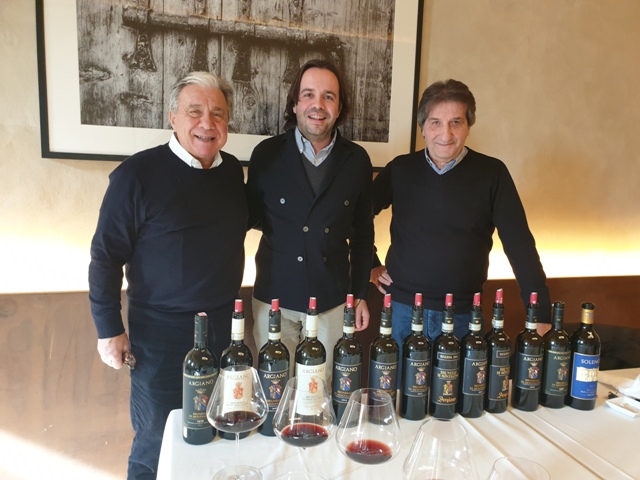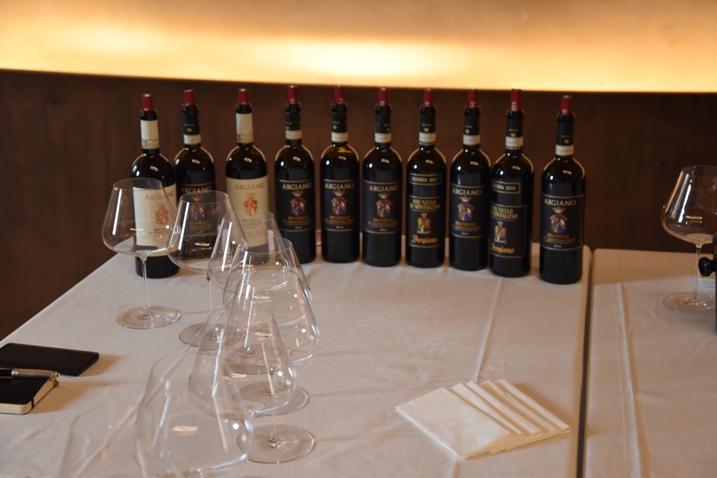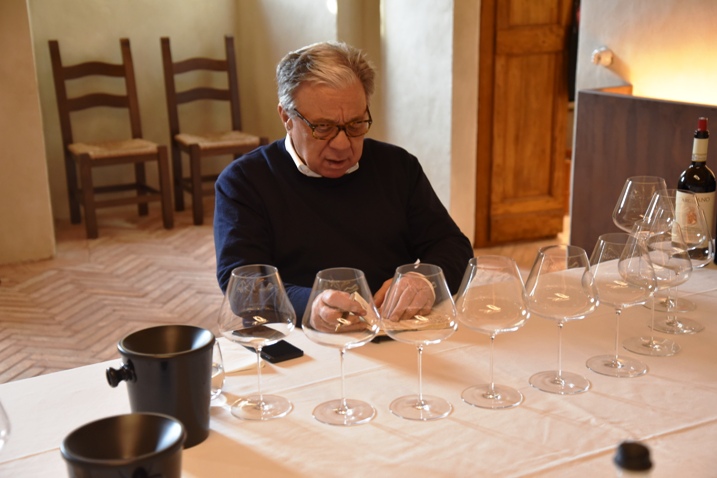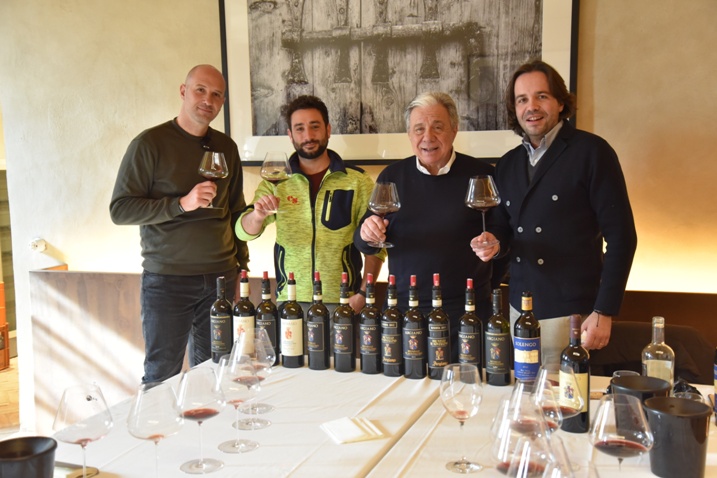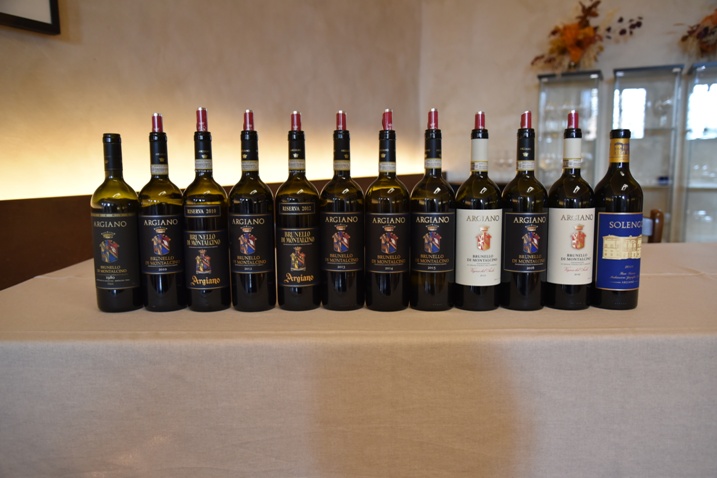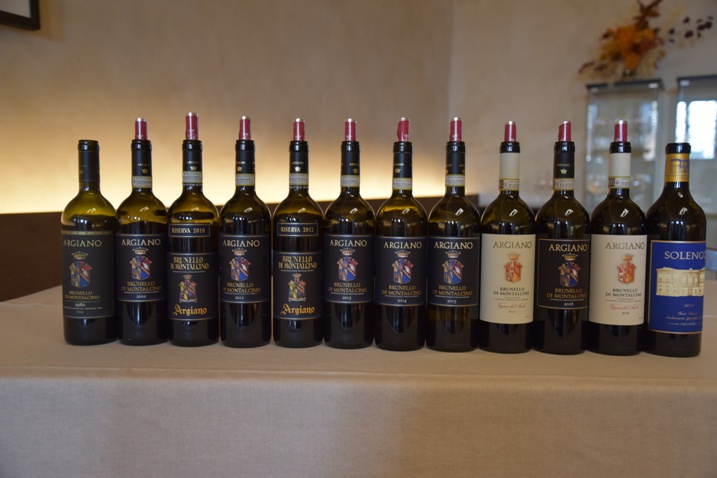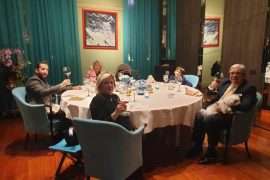The Argiano company has very ancient origins. It was the Pecci family who built the Villa and the cellar in 1581. Over time, there have been numerous changes in ownership by noble Sienese families. It goes without saying that the company is one of the oldest in Montalcino and that in 1967 it was one of the 25 founding companies of the Brunello consortium.
The first Super Tuscan wine from Montalcino is due to Giacomo Tachis, father of Italian enology. In 2012 the owner Noemi Marone Cinzano sold the company to the Brazilian Andrè Estevens who completely revolutionized everything: vineyards, personnel and study of the land.
In 2013 the geologist Pedro Parra and the agronomist Francesco Monari began to study the micro-parcels of the company’s land. In 2013, the complete conversion to organic and eco-sustainable crops takes place. In 2014 the first six Sangiovese crus are identified.
The 2015 is the first vintage of Vigna del Suolo that already gave its best at its debut.
In 2016 the new cellar was built and the underground cellar was renovated. The Villa was conservatively restored in 2017. The professional who restored the Villa and the cellars is the young architect Gastone Filippo Scheggi.
In 2019 it acquired the leadership of a plastic-free company in Montalcino. The company is located in the Sant’Angelo in Colle hamlet, to the south-west. This area has a mild climate and drier summers than the northern area. The influence of the sea is also important with frequent winds from the West.
The vineyards are of sangiovese for 40 hectares, 7 hectares of cabernet sauvignon, 4 hectares of merlot and 4 hectares of petit verdot. There are also 10 hectares of olive trees.
The company is located at an altitude ranging from 290 to 315 meters above sea level. The soils are rich in marl and limestone.
The new company philosophy is to create wines that identify perfectly with its soils. From this, the meticulous study of soil types and soil stratigraphy, with identification of the microterroirs.
The microterroirs are:
Terroir n. 1, POGGIO AL VENTO: has a first layer that is one meter deep and is composed of oceanic clay (blue clay), compact but full of small fractures in summer. The clay keeps the moisture in the soil and its fractures cause the roots to go deep. Descending 120 cm from the surface is the marl, rich in limestone, which gives structure and minerality to the wine.
Terrior n. 2: POGGIO AL VENTO: here there is the oceanic clay that reaches a depth of 150 cm, here too we have sharper fractures and this gives great resistance to the lack of water and this will result in the roots being more decisive in the go deeper, in search of their livelihood.
At a depth of 170 cm the roots will find a very fractured marl, which will facilitate a greater distribution of the roots which will absorb generous doses of mineral.
Terrior n. 3: POGGIO AL VENTO: looks like no. 2, however, has less fracturing, in the clayey and marly layers, the fractures are clearer and this allows the roots to descend in a strong and decisive way, fortifying and making the root system longer.
Terrior n. 4: FORNACE: The first layer is 170 cm and is made up of darker, non-compact and porous clayey limestone soil. All this gives elegance and structure to the wine. The vineyard dates back to 1965. The roots go over 3 meters deep and have an old 140 ruggeri rootstock. The second layer is made up of calcareous marl rich in minerals, with homogeneous and well distributed roots that favor perfect absorption. All this means that the wines are structured, mineral and fragrant.
Terrior n. 5: FORNACE NUOVA: The first layer is of a black oceanic clay, with metamorphic and calcareous sediments that make it less compact with a darker color. The second layer reaches two meters and has crystallized mineral layers with bundles of roots running through it.
Beyond two meters there is a third layer composed of calcareous marl with abundant fractures that allow optimal root absorption.
Terrior n. 6: FORNACE NUOVA: The first layer is about 170 cm deep and is rich in oceanic clays mixed with metamorphic and calcareous sediments.
Thanks to the high degree of fracturing, the roots cross the entire layer homogeneously. Beyond two meters there is calcareous marl with discrete fracturing that tends to deepen with the passage of time. Wines are usually very elegant.
The vinifications take place separately on the basis of the micro-terroir.
The clones of the company’s Sangiovese are recorded and reproduced in order to have their own biotype. Agriculture is strictly organic and no fertilizers or pesticides are used. The new concept is to see the soil as a true and unique living source of nourishment with the use and strengthening of useful microorganisms. To do all this, a biological fight against insects must also be implemented. Reuse of seeds.
Pruning, stalks and pomace form the compost.
As I have already said, it is essential to study the micro-terriors and the wines that come from them, observing their different aromas, structure and taste.
In the cellar if possible, the fermentations are spontaneous and the macerations are short and delicate.
Sangiovese is aged in large barrels. The dosages of SO2 are low and the pre-bottling refinement takes place in cement. The company wants to make wines that identify with their territory and more precisely with their company. I say stop with trade diversions that destroy the identity of wines and territories. Stop with certain consultants, who have done so much harm to wine by creating uniform wines that do not identify the territory and the types of wines.
Argiano understood this well. The company team is well motivated in seeking this, Bernardino Sani CEO / winemaker, a very pleasant and competent person, has created a good group of motivated young people in this, not easy, business project. The agronomist is Francesco Monari, Roberto Caporossi is the internal oenologist, Riccardo Brogi is the commercial director while Alberto Antonini is the external oenologist who, in my opinion, is experiencing a second working youth.
Alberto Antonini is well motivated, he has understood very well that companies with their wines must express the territory, as this is the winning card, without conditioning and without compromise. Italy, and Montalcino in particular, has understood that one’s identity constitutes one’s pride and strength.Dario Pettinelli is a consultant and communications director of the company.
The wines produced by the company are Rosso di Montalcino, Brunello di Montalcino, Brunello di Montalcino Riserva, Brunello di Montalcino “Vigna del Suolo”, NC IGT Toscana (Grapes: Cabernet Sauvignon, Merlot and Sangiovese) and Solengo Toscana IGT (Grapes: Cabernet Sauvignon, Petit Verdot, Merlot and Sangiovese.
Having made these important premises about the company, I am going to talk about my visit to the company aimed at getting to know the new company philosophy and making a vertical of Brunello di Montalcino, as well as tasting the wines just released on the market. The impression I got is that, unlike in the past, where the wines were perhaps more powerful, the latter ones are fine and elegant with the right structure but with silky tannins and a good gustatory balance.
I felt wines delight the palate with a graceful and persuasive drink.
This is the Sangiovese that I love, with fruity and floral notes without the interference of wood, those wines that make you want to drink them and drink them again.
As for the width of the tannin, it is important that you make the following clarifications, so that it can be understood. I feel the tannin of the wine on the upper gum. The total width of the tannin is 6/6, therefore the entire width of the upper gum. Obviously, if the tannin is less broad, it could be for example 5/6 and so on. The width of the tannin is important when the quality of the same is of good or high level. If the tannin is broader, the more the wine is worthy of attention, but the tannin, as I have specified, must in any case be of good quality.
Let’s now pass to describe the wines tasted.
FATTORIA DI ARGIANO
Brunello di Montalcino, vintage 2010
Ruby red color.
The glass detects aromas of cherry, mint, eucalyptus, starch of the cotton fabric, bay leaf, licorice, sage, rosemary, black pepper, nutmeg, light fresh pecorino cheese, partially dried plum, to finish with touches of vegetable skin (it is the worked leather that approaches the sweetness of the cowhide).
On the palate you can enjoy an excellent and tasty cherry.
The wine is savory and has a medium-fine body.
Alcohol and freshness are a little fluctuating between them, while the tannins are sweet, fairly broad (5/6 +) initially silky and then dry the upper gum a little (wood tannins?).
Its intense aromatic persistence is long.
Pleasant wine but with a slight pungency of alcohol even on the nose.
(91/100)
FATTORIA DI ARGIANO
Brunello di Montalcino Riserva, vintage 2010
Intense ruby red-black robe with slight purple textures.
The nose immediately reveals woody notes that are also identified with the aromas of the “after eight” chocolate (mint and chocolate) followed by notes of cherry, eucalyptus, rosemary, sage, bay leaf, black pepper, nutmeg, vegetable leather (worked leather that approaches the sweet of the cowhide) plum, to finish with sweet notes reminiscent of the outside of the sugared almond.
On the palate it feels a bit bitter wood and flavors of plum and licorice.
The body is medium plus. Well balanced wine between alcohol and freshness, the latter is well present. The tannins are sweet, fairly broad (5 / 6-) initially silky and then dry the upper gum a little.
Its gustative persistence is long with a woody finish and after eight chocolate already felt on the nose. It will probably take a few years for the wine to absorb the wood.
(90 – / 100)
FATTORIA DI ARGIANO
Brunello di Montalcino, vintage 2012
A beautiful ruby red glows
Varied and pleasant nose with aromas of toasted peanut, cherry, plum, mint, eucalyptus, tannery leather at the end of processing, wild strawberry levi, bay leaf, sage, slight LPG gas, blond leather, the fresh one, to end with whispers of wet earth.
When tasted, the wine has a good drink even if the gustatory balance is slightly fluctuating, between alcohol and freshness. The body is medium and the tannins are sweet, fairly broad (5/6 +), initially silky and then slightly dry the upper gum. Its gustative persistence is long but not very long.
(91/100)
FATTORIA DI ARGIANO
Brunello di Montalcino, reserve, vintage 2012
Ruby red dress.
At the olfactory encounter the aromas of medicine drawer, dried porcini mushroom, mint, eucalyptus, cherry, intense plum, starch of the cotton fabric stand out, ending with pinches of vegetable leather (it is the worked leather that approaches the sweet of the cowhide ).
On the palate it reveals a sufficient medium body but fine and elegant. The wine is balanced for alcohol because freshness dominates it without hesitation. The tannins are sweet, wide (6 / 6–), initially silky and then dry the upper gum a little. Its gustative persistence is long but not very long, with a cherry finish.
(92 – / 100)
FATTORIA DI ARGIANO
Brunello di Montalcino, vintage 2013
Ruby red and light garnet color.
From the glass rise aromas of fine tannery leather, LPG gas, starch for ironing, violet, hard almond shell, cherry, bay leaf, sage, slight rust, Atkinson lavender soap, warm ironed cloth, black truffle to finish with strokes of hard barley candy.
In the mouth it is perceived a medium body, a nice juicy pungency, cherry and a pleasant black truffle.
The freshness completely covers the alcoholic mass making the wine balanced.
The tannins are sweet, thick, fairly wide (5/6 +) initially velvety and then slightly dry the upper gum.
Its gustative persistence is long with a fruity and slightly bitter finish.
For the thick tannins it reminds me of the 2006 vintage in Montalcino.
(93/100)
FATTORIA DI ARGIANO
Brunello di Montalcino, vintage 2014
Looking at it, it has a beautiful light garnet red. Olfactory blend made up of perfumes from the outside of the sugared almond, fine tannery leather, mint, eucalyptus, plum, cherry, with hints of black pepper and nutmeg in the finish. On the gustatory encounter, a medium body and a slightly sour note are perceived, due to the difficult vintage. The wine has a good gustatory balance with the alcoholic mass dominated by freshness and tannins. The latter are sweet, fairly wide, initially velvety and then dry the upper gum a little. Its gustative persistence is long.
(90 – / 100)
FATTORIA DI ARGIANO
Brunello di Montalcino, 2015 vintage
It has a light garnet red color.
From the glass rise pleasant fruity aromas of cherry, hairy red peach and floral lavender that reminds me of Atkinson soap. The olfactory path continues with notes of starch (starch for ironing), eucalyptus and leather saddle.
Tasting reveals a medium body and the wine is immediately pleasant, fine and elegant, with a fruity cherry flavor. Well balanced wine with imperceptible alcoholic mass thanks to the freshness and the tannins that dominate it. The tannins are sweet, wide (6 / 6–), initially silky and then slightly dry the upper gum. Its gustative persistence is long. Pleasant wine.
(94 + / 100)
FATTORIA DI ARGIANO
Brunello di Montalcino
“Vigna del Suolo”, vintage 2015
Ruby red mantle, clear.
Various and pleasant aromas of cherry, mint, eucalyptus, hairy red peach, light rubber, Atkinson lavender soap, to finish with spicy flavors of black pepper and nutmeg.
The drink is very pleasant and the fairly delicate body caresses the whole oral cavity. Well balanced wine thanks to the freshness and the tannins that do not make you feel, even in the slightest, the alcoholic mass. The tannins are sweet, silky and broad (6 / 6–). Its persistence is long with a cherry finish. In my notes I wrote: it lacks a bit of structure but has a nice drink.
(95/100)
FATTORIA DI ARGIANO
Brunello di Montalcino, vintage 2016
A delicate ruby red shines through the glass.
Intense aromas of starch spray on a warm cloth and cherry. Followed by puffs of toasted peanuts, mint, eucalyptus, cotton candy, slight hints of wood to finish with spicy flavors of black pepper and nutmeg.
On the palate it has a medium body, cherry flavor and a perfect gustatory balance with imperceptible alcoholic mass. The tannins are sweet, wide (6 / 6-), elegant, initially silky and then slightly dry the upper gum in the final.
Pleasant wine.
(95/100)
FATTORIA DI ARGIANO
Brunello di Montalcino
“VIGNA DEL SUOLO”, vintage 2016
Transparent ruby red.
From the glass they go upwards intense and pleasant aromas of toasted peanuts and lavender soap that reminds me of the Atkison soap, followed by vegetable skin (it is the skin that approaches the sweet of the cowhide), mint, eucalyptus, pepper black, intense nutmeg to finish with whispers of tomato paste.
The taste has a beautiful structure and is sapid and mineral with a cherry flavor. Perfectly balanced wine with freshness axis and tannin that dominates the alcoholic mass.
The tannins are sweet, thick, elegant, wide (6 / 6–) and velvety. Its gustative persistence is long with a cherry finish. Nice wine which, for me, does not reach the maximum score due to the incomplete width of the tannins which over time will have to become less thick and more silky. Great wine!
(98/100)
FATTORIA DI ARGIANO
Brunello di Montalcino, vintage 1980
Brick red with an orange edge.
From the olfactory casket rise aromas of dried porcini mushroom, wet earth, black pepper, aged leather saddle, intense with rust, carob, mint, eucalyptus, semi-fresh pecorino, shredded tobacco of the Tuscan cigar, to finish, in the empty glass, with hints of juniper berry.
On the palate you can feel the taste of dried porcini mushroom, already smelled on the nose. The body is medium and the wine has a good gustatory balance with the freshness and tannins in evidence on the alcoholic mass.
The tannins are sweet, thick, silky and fairly broad (5 / 6–). Its gustative persistence is long with a finish of zabaglione, licorice candy and mint.
The note of dried porcini mushroom denotes the descending phase of the wine which however continues to be interesting, both on the nose and on the palate.
(92 ++ / 100)
FATTORIA DI ARGIANO
“SOLENGO”, vintage 2018
Tuscany IGT
(GRAPES: 50% Cabernet Sauvignon, 25% Petit Verdot, 20% Merlot and 5% Syrah)
Ruby red and purple mantle.
Captivating nose with intense aromas of fresh squeezed plum, blueberry, cassis followed by worked leather, black pepper, nutmeg to finish with caresses of small licorice beans.
Pleasant sip, which highlights a medium body and a perfect gustatory balance, thanks to the freshness and tannins that dominate the alcoholic mass.
The tannins are sweet, thick, broad (6 / 6-) and velvety. Slightly woody and squeezed plum flavor that persists during its long intense aromatic persistence. Nice interesting and pleasant wine that needs to lose some wood and to slim down the tannins a little.
At the time of tasting the wine had not yet been released on the market, requiring a further stop in the bottle, and for this reason the evaluation has a minimum and maximum range.
(97-99 / 100)

